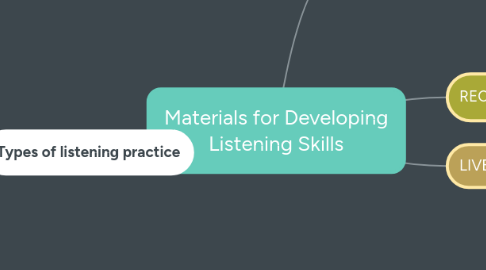
1. Types of listening practice
1.1. One-way listening
1.2. Two-way listening
1.3. Brown’s classification
1.3.1. Reactive
1.3.2. Intensive
1.3.3. Responsive
1.3.4. Selective
1.3.5. Extensive
1.3.6. Interactive
1.4. Rost’s classification
1.4.1. Intensive listening
1.4.1.1. Focus on phonology,syntax,lexis
1.4.1.2. Listening to a text closely for the future analysis
1.4.1.2.1. Analysis happens at the level of sounds/words/grammatical units
1.4.1.3. Vehicle for practicing pronunciation,vocab,grammar
1.4.1.4. Rost suggests dictation, elicited repetition,error spotting and simultaneous interpretation-bottom up skills(that’s how Brown said)
1.4.2. Selective listening
1.4.2.1. Brown suggests to scan audio materials SELECTIVELY
1.4.2.1.1. People’s names
1.4.2.2. Rost-planned purpose in mind
1.4.2.3. Morley suggests to use more complex activities in academic context
1.4.3. Interactive listening
1.4.3.1. Conversational interaction with feedback
1.4.4. Responsive Listening
1.4.5. Autonomous Listening
1.4.6. Extensive listening
1.4.6.1. Watching movies ,listening to radio programs
2. APPs for improving listening skills
2.1. LYRICS TRAINING - combines listening to songs with learning a language LISTEN NOTES - collection of podcasts on a wide range of topics. SYNTH - PODCAST FLUID DATA - shows you a list of audio clips with the part of the clip that contains the example phrase TECHVID - combines listening with
2.1.1. accant Rosie-Facebook- massages- short audio clips
3. RECORDED MATERIALS
3.1. ADVANTAGES OF RECORDED MATERIALS
3.1.1. DISADVANTAGES OF RM
4. LIVE LISTENING
4.1. ADVVANTAGES OF LIVE LISTENING
4.1.1. DISADVANTAGES OF LL
